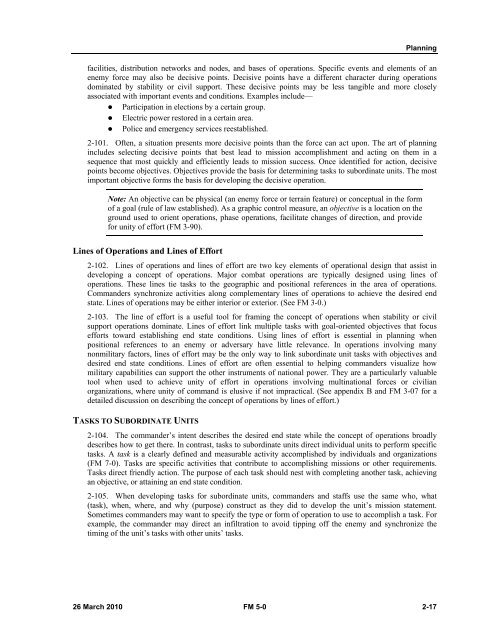FM 5-0, The Operations Process - Federation of American Scientists
FM 5-0, The Operations Process - Federation of American Scientists
FM 5-0, The Operations Process - Federation of American Scientists
You also want an ePaper? Increase the reach of your titles
YUMPU automatically turns print PDFs into web optimized ePapers that Google loves.
Planning<br />
facilities, distribution networks and nodes, and bases <strong>of</strong> operations. Specific events and elements <strong>of</strong> an<br />
enemy force may also be decisive points. Decisive points have a different character during operations<br />
dominated by stability or civil support. <strong>The</strong>se decisive points may be less tangible and more closely<br />
associated with important events and conditions. Examples include—<br />
• Participation in elections by a certain group.<br />
• Electric power restored in a certain area.<br />
• Police and emergency services reestablished.<br />
2-101. Often, a situation presents more decisive points than the force can act upon. <strong>The</strong> art <strong>of</strong> planning<br />
includes selecting decisive points that best lead to mission accomplishment and acting on them in a<br />
sequence that most quickly and efficiently leads to mission success. Once identified for action, decisive<br />
points become objectives. Objectives provide the basis for determining tasks to subordinate units. <strong>The</strong> most<br />
important objective forms the basis for developing the decisive operation.<br />
Note: An objective can be physical (an enemy force or terrain feature) or conceptual in the form<br />
<strong>of</strong> a goal (rule <strong>of</strong> law established). As a graphic control measure, an objective is a location on the<br />
ground used to orient operations, phase operations, facilitate changes <strong>of</strong> direction, and provide<br />
for unity <strong>of</strong> effort (<strong>FM</strong> 3-90).<br />
Lines <strong>of</strong> <strong>Operations</strong> and Lines <strong>of</strong> Effort<br />
2-102. Lines <strong>of</strong> operations and lines <strong>of</strong> effort are two key elements <strong>of</strong> operational design that assist in<br />
developing a concept <strong>of</strong> operations. Major combat operations are typically designed using lines <strong>of</strong><br />
operations. <strong>The</strong>se lines tie tasks to the geographic and positional references in the area <strong>of</strong> operations.<br />
Commanders synchronize activities along complementary lines <strong>of</strong> operations to achieve the desired end<br />
state. Lines <strong>of</strong> operations may be either interior or exterior. (See <strong>FM</strong> 3-0.)<br />
2-103. <strong>The</strong> line <strong>of</strong> effort is a useful tool for framing the concept <strong>of</strong> operations when stability or civil<br />
support operations dominate. Lines <strong>of</strong> effort link multiple tasks with goal-oriented objectives that focus<br />
efforts toward establishing end state conditions. Using lines <strong>of</strong> effort is essential in planning when<br />
positional references to an enemy or adversary have little relevance. In operations involving many<br />
nonmilitary factors, lines <strong>of</strong> effort may be the only way to link subordinate unit tasks with objectives and<br />
desired end state conditions. Lines <strong>of</strong> effort are <strong>of</strong>ten essential to helping commanders visualize how<br />
military capabilities can support the other instruments <strong>of</strong> national power. <strong>The</strong>y are a particularly valuable<br />
tool when used to achieve unity <strong>of</strong> effort in operations involving multinational forces or civilian<br />
organizations, where unity <strong>of</strong> command is elusive if not impractical. (See appendix B and <strong>FM</strong> 3-07 for a<br />
detailed discussion on describing the concept <strong>of</strong> operations by lines <strong>of</strong> effort.)<br />
TASKS TO SUBORDINATE UNITS<br />
2-104. <strong>The</strong> commander’s intent describes the desired end state while the concept <strong>of</strong> operations broadly<br />
describes how to get there. In contrast, tasks to subordinate units direct individual units to perform specific<br />
tasks. A task is a clearly defined and measurable activity accomplished by individuals and organizations<br />
(<strong>FM</strong> 7-0). Tasks are specific activities that contribute to accomplishing missions or other requirements.<br />
Tasks direct friendly action. <strong>The</strong> purpose <strong>of</strong> each task should nest with completing another task, achieving<br />
an objective, or attaining an end state condition.<br />
2-105. When developing tasks for subordinate units, commanders and staffs use the same who, what<br />
(task), when, where, and why (purpose) construct as they did to develop the unit’s mission statement.<br />
Sometimes commanders may want to specify the type or form <strong>of</strong> operation to use to accomplish a task. For<br />
example, the commander may direct an infiltration to avoid tipping <strong>of</strong>f the enemy and synchronize the<br />
timing <strong>of</strong> the unit’s tasks with other units’ tasks.<br />
26 March 2010 <strong>FM</strong> 5-0 2-17















